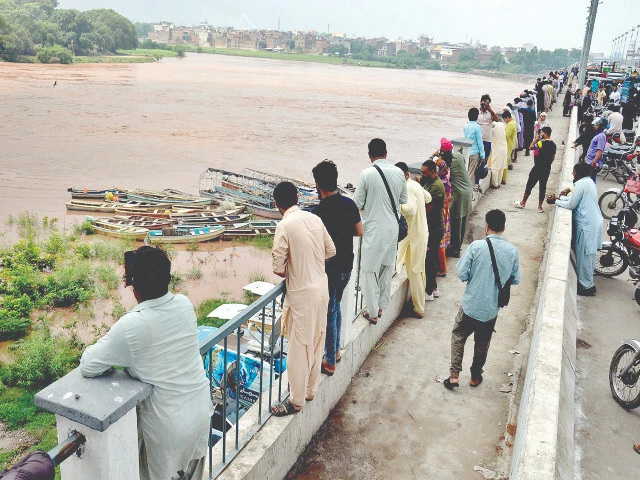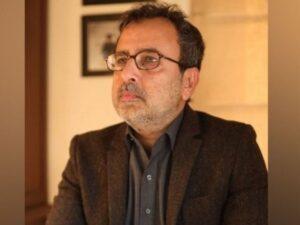The floods in the Chenab, Sutlej and Ravi rivers have devastated nearly 1,400 villages across Punjab, moving more than 1.2 million people.
Along the Chenab, 991 villages and 769,281 people were affected, while Ravi River Bank Burst assigned 80 villages and 74,775 residents, and Sutlej flooded 361 villages, moving 392,768 people.
In addition to human evacuations, more than 148,000 cattle have been moved to safer areas, with 234 animal treatment camps set up to provide medical support. More than 210,000 people were transferred to safer places, including 25,000 hosted in resistance camps, according to the National Disaster Management Authority (NDMA) on Thursday.
The Rivers Chenab and Jhelum have respectively reached extremely high and very high flood levels, flooding vulnerable districts, said the flood forecast division of the province of disaster management (PDMA) Lahore (FFD).
28 اگست صبح 6 بجے ڈیمز ، دریاؤں کے اہم مقات پر پانی کے OF pic.twitter.com/srdigmelhs
– ffdlahore (@ffdlhr) August 28, 2025
The Chenab river is experiencing extremely high levels of Khanki head, Qadirabad and downstream from Marala.
In Khanki, the river is in an extremely high flooding situation with flows reaching 859,000 brackets. Similarly, at the head of Qadirabad, the discharge increased to 996,000 Cusec, which is less than 200,000 brains above its design capacity, also classified as an extremely high level of flood.
Understand the flood levels
According to FFD, the flood levels are classified into five steps:
- A “low flood level” is the place where the river flows are just above normal and generally contained in the banks.
- An “average flood” indicates a stronger increase in water, posing risks for villages and low crops near the banks.
- When a “high flood” is declared, the situation becomes dangerous because the water can overcome or exert strong pressure on the embankments.
- While a “very high flood signals” a critical step where a large -scale flood is expected.
- The most severe category is an extremely high flood, where river discharges exceed the secure design limits of dams and embankments.
Read: Heartland Under Water Siege
Chenab River
Due to the swelling of the Chenab river, more than 50 villages in Sambrial have been overwhelmed, while the number of deaths in drowning has increased to at least eight. Friday, the extremely high flood wave in the river reached Muzaffargarh. Residents are increasingly worried due to the poor condition of protective embankments, with cracks reported in Ranpur, Muradabad, Bhattianwali Basti, Thitta Sialan and Sankhi.
Ravi river
MoroEver, the water flow in the Ravi river continues to increase, reaching 189,000 Cusecases in Shahdara and is expected to hit 200,000 brackets in the coming hours. The flood waters have exceeded the banks, spreading in the neighboring colonies around Shahdara. Mosques in the region announce evacuation calls as water levels increase. The district administration has released 22 villages in five Tehsils de Lahore.
According to the Punjab PDMA DG IRFAN ALI KATHIA, in Jassar, Ravi River has reached extremely high flood levels with flows at 139,000 CUSECs, News reported. In Balloki Headworks, the flows are 93,000 brackets, marking a medium level flood.
In the district of Shakargarh, hundreds of agricultural land acres have been overwhelmed, dozens of houses collapsed and at least three people lost their lives.
In Ganda Singh Wala, the Sutlej river is experiencing an extremely high and dangerous deluge with water flows recorded at 261,000 CUSECs. With the Sulemanki head, the flows have reached 109,000 brackets, causing an average level flood.
Find out more: Gates gives $ 1 million for Pakistani floods
In Vehari, the protective embankments of Lakha sildira and Jatiera collapsed, allowing the flood waters to enter the villages Lakha sildira and Jatiera while cutting access to the road to more than 40 colonies.
The district authorities said that more than 50,000 people had been affected by vehicles alone, with more than 12,000 safer locations and tent colonies established in Farooqabad, Sahuka and Rakh Jamlera.
In Bahawalnagar, several temporary protective dikes have also collapsed due to the high flood water current.
Meanwhile, the Industry river remains relatively calm in Punjab, with low flood levels reported in Rajanpur, although managers warn that a high flood wave should reach Kot Mithan in three to four days. Police and the district administration have started to move residents from the Katcha regions, with rescue camps and deployed rescue teams. In the Sindh, the Indus in Taunsa, Guddu, Sukkur, Kotri and Islam Headworks remain at low flood.
According to the latest alert of Pakistan Meteorological Department (PMD) published today, the following 12 to 48 hours remain essential, with forecasts of new strong precipitation in Lahore, Gujranwala, Siackot, Jhelum, Rawalpindi, Murrier, Azad Kashmir and Gilgit-Baltistan.
PM highlights the need to improve water storage capacity
Prime Minister Shehbaz Sharif called for collective efforts to meet the recurring challenge of natural disasters, in particular floods, in the coming years.
Chair a briefing in Narowal on the devastation caused by recent floods, the PM has stressed the need to improve the water storage capacity to mitigate sudden floods. He said that the Diamer Bhasha and Mohmand dams can be used as key projects, adding that water tanks could also be developed in Chiniot.
Prime Minister Shehbaz said that federal and provincial governments have the ability to generate resources and find solutions to the crisis. He pointed out that, with the national and provincial disaster management authorities, all the Allied departments must demonstrate their preparation to combat natural calamities.
Expressing sorrow concerning loss of life and property, the Prime Minister praised the armed forces for having worked closely with the civil administration in rescue and rescue operations.
The president of the NDMA, Lieutenant-General Inam Haider, Malik, informed the meeting on the scale of the damage, noting that the monsoon of this year had been more intense and prolonged than in previous years, with high flood waters recorded in the Rivers Chenab, Sutlej and Ravi.
Earlier in the day, Prime Minister Shehbaz arrived in Lahore, where the chief minister of Punjab, Maryam Nawaz, welcomed her.
CM Maryam visits the areas affected by the floods
The chief minister of Punjab, Maryam Nawaz, inspected the situation of the floods in Shahdara during her boat trips, where the officials informed him of the last development.
Speaking on occasion, she said that Punjab faced an emergency of the floods after “unprecedented rains and the liberation of India water after the reduction of its dams”.
She congratulated the efforts of the administration, noting that the commissioners, the assistant commissioners, the rescue teams and the health service had worked tirelessly.
“If there had been no preparation, the damage would have been much more important. Such a flood occurred after 38 years. Each life is precious and people were moved to safe places,” she added.
شدید ترین بارشوں اور بھار Cip کی جانب سے پانی چھوڑنے ب بعد سیلابی صورتال ہے
یہ ایک غیر معمولی صورتحال ہے
بھا OF
تمام ادارے quet
ان YP
ریسکیو ، ہیل yp
ویر اعظم نارووال… pic.twitter.com/98py3MCGX
– PTV News (@ptvnewsofficial) August 28, 2025
“By the grace of Allah, we were saved from mass destruction, although I deeply regret the losses that have occurred”.
Public opinion
The assistance commissioner of the PDMA PDMA, Nabeel Javed, ordered the assistant commissioners to remain present on the ground, stressing that the PDMA ensures continuous coordination in the province.
He said that the evacuations of the areas affected by the floods must be carried out as quickly as possible, because the protection of lives and goods remains priority and responsibility. All relevant rescue and rescue institutions have been placed on high alert, without place for negligence.




